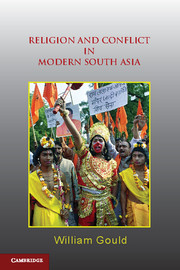Book contents
- Frontmatter
- Contents
- Abbreviations
- Glossary
- Acknowledgements
- 1 Introduction
- 2 Building Spheres of Community
- 3 Transforming Spheres of Community
- 4 Defining Spheres of Community
- 5 State Transformation, Democracy and Conflict
- 6 Forging National Consensus and Containing Pluralism
- 7 New Conflicts and Old Rivalries
- 8 The Resurgence of Communalism?
- Conclusion
- Bibliography
- Index
3 - Transforming Spheres of Community
The Post–First World War Colonial World
Published online by Cambridge University Press: 05 June 2012
- Frontmatter
- Contents
- Abbreviations
- Glossary
- Acknowledgements
- 1 Introduction
- 2 Building Spheres of Community
- 3 Transforming Spheres of Community
- 4 Defining Spheres of Community
- 5 State Transformation, Democracy and Conflict
- 6 Forging National Consensus and Containing Pluralism
- 7 New Conflicts and Old Rivalries
- 8 The Resurgence of Communalism?
- Conclusion
- Bibliography
- Index
Summary
Following the end of the Great War, the basis of British power in India changed significantly. In an attempt to appease what it considered to be new political interest groups, the British and Indian governments reformed the basis of representative politics as a result of promises of ‘gradual realisation of responsible government’ during the war. Crucially, some Indian subjects were given more powers at the provincial level. The financial and fiscal basis of the Raj shifted in tandem, with more focus on the flexible revenues of income tax, rather than land revenues, which brought different middle-class publicists into negotiation in the reformed legislatures. The 1920s was also a time of dramatic change for ‘communal’ politics, particularly from the point of view of public discussions about the prevalence of riots and more minor clashes across north India. Historians have tended to chart the occurrence of communal violence in waves. Whereas, following non-cooperation from 1922, there were more ‘riots’ in absolute terms (particularly in north India), following the end of Civil Disobedience in 1934, this violence appeared to decline until the 1940s. Again, by the early 1950s, for three decades, mobilisation around religious community declined dramatically again, it seems, at least in terms of the occurrence of conflicts and riots. However, charting the ebb and flow of the politics of ‘communalism’ according to the prevalence of riots is problematic. First of all, there were, and continue to be, often very local and contingent reasons for such conflicts. Moreover, the reason for such violence is rarely as straightforward as government reports and the media set out. What is significant, however, is how the notion and discussion of ‘communalism’ changed in the interwar period. And here, riots and conflicts were important in informing a public sense of religious antagonism.
This chapter will look at how this process was linked to specific changes in the relationship between the state at all levels and power brokers in Indian society who sometimes worked through civic institutions, and it will be followed in the by a consideration of the deeper social bases of religious mobilisation. One of its main arguments will be that the 1920s was a period in which the legitimacy of the colonial state was questioned in new and more radical ways than ever before by a range of institutions, leaders and publicists. This led to the setting up of a range of parallel quasi-state organisations and bodies. These revolved around local structures of mobilisation and power, generated by heightened competition and new claims to political recognition by community and caste organisations. The changing significance of class and other ethnic identities, as the state attempted to redefine minority and special interests, was also important, and these themes will be taken up in .
- Type
- Chapter
- Information
- Religion and Conflict in Modern South Asia , pp. 80 - 118Publisher: Cambridge University PressPrint publication year: 2011



